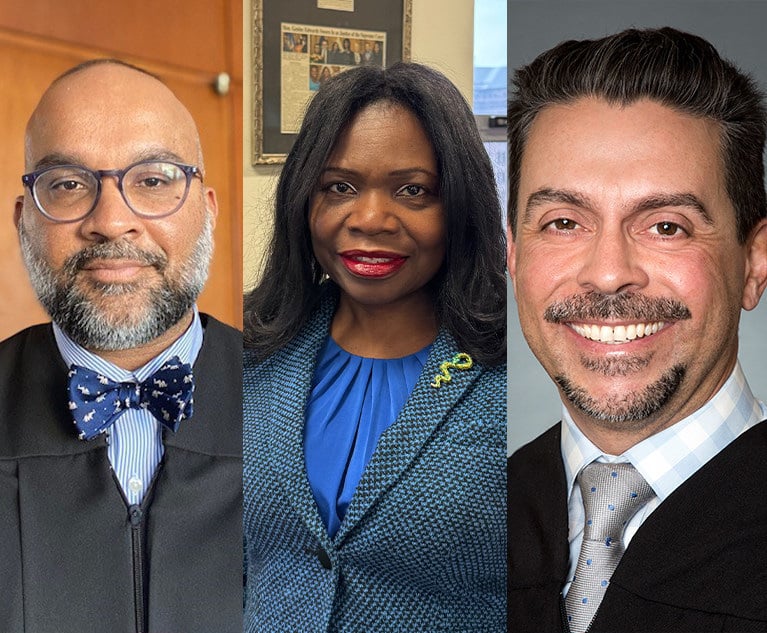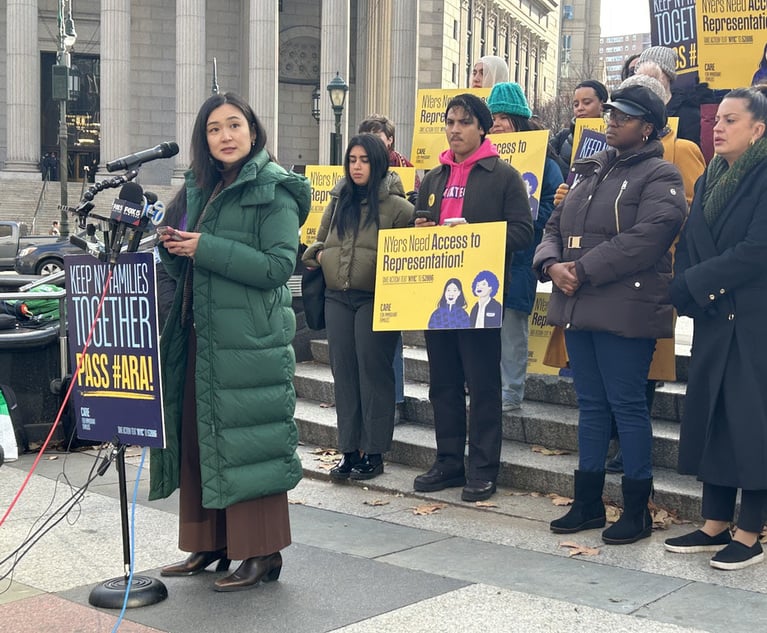 Asbestos chrysotile fibers. Photo: Shutterstock
Asbestos chrysotile fibers. Photo: ShutterstockNew Report Finds Many Asbestos Plaintiffs Fail to Identify Bankruptcy Trust Claims in Discovery
Legislation pending before state lawmakers in Albany could change that strategy by requiring plaintiffs to first file claims with those trusts before pursuing damages in state court.
November 01, 2019 at 04:21 PM
6 minute read
A new study by the New York Civil Justice Institute suggested that plaintiffs in nearly half of asbestos-related cases in New York may not have first taken advantage of bankruptcy trusts set up specifically to fund those claims, thus likely missing out on an automatic payout.
The nonprofit civil litigation research organization, in an examination of 175 asbestos-related cases in New York, found that many litigants over the past six years did not say in the course of their lawsuits whether they first sought relief elsewhere.
Legislation pending before state lawmakers in Albany could change that strategy by requiring plaintiffs to first file claims with those trusts before pursuing damages in state court.
The procedure for seeking damages for exposure to asbestos can be confusing for someone who hasn't practiced that area of law.
Several companies, decades ago, agreed to set up a series of bankruptcy trusts that individuals can file asbestos-related claims with to seek monetary relief. Rather than pursue litigation, the trusts allow an easier path for litigants to collect damages.
That's not the case for companies that haven't gone bankrupt over the years. Litigants seeking asbestos-related damages from those entities still have to take their case to court.
But litigants can also take advantage of both options under current state law. They can first seek damages through litigation over their exposure to asbestos, then later file a claim with various trusts associated with the liability.
For about half the cases the New York Civil Justice Institute looked at in its report, litigants did not identify any claims filed with bankruptcy trusts before they sought relief in court.
Attorneys Mary Margaret Gay and Sarah Beth Jones from the Jackson, Mississippi, law firm Gay Jones & Kuhn, looked at 175 asbestos-related case in New York for the report. Those cases were picked from a much larger data set because they had proceeded to trial.
Each case reviewed in the report was brought by a plaintiff who was eligible to receive payments from an asbestos bankruptcy trust before they filed their lawsuit, the report said.
Despite that, the report found that only 54% of the plaintiffs identified some filed trust claims during discovery, or information that's exchanged between parties before trial. The other plaintiffs did not identify any claims filed with bankruptcy trusts.
Gay said in an interview with the New York Law Journal that, because state law allows litigants to skip filing trust claims or identifying them in court, asbestos-related litigation is different than other areas of injury law. Defendants aren't aware of all the claims and exposures, she said.
"It is impossible to properly value a case in the tort system without knowing, as you would in any other litigation, what the plaintiff is going to receive to compensate them for their injury," Gay said.
That makes it difficult for attorneys to compare where else the plaintiff may plan to seek damages and balance the liability between those entities.
Three of the plaintiffs reviewed by the report were entitled to more than $1 million in estimated trust claims payments, according to the report. One plaintiff who sought damages from a mesothelioma diagnosis was eligible for $1.2 million, the report said.
By the numbers, many of the plaintiffs didn't take advantage of dozens of bankruptcy trusts with which they could have filed a claim.
Of the cases reviewed, 13 of the plaintiffs could have made more than 40 bankruptcy claims. Close to a third of the plaintiffs, 52, could have made at least 25 bankruptcy claims. About 20% of the cases were eligible for at least $500,000 in trust claim payments, the report said.
The amount each plaintiff could have filed for with the various eligible bankruptcy trusts varied among the plaintiffs, but the report found that those with mesothelioma may have received payments of more than $440,000 on average.
If the plaintiffs in those cases had filed the trust claims before seeking litigation, and disclosed those payments in court, the defense may have been able to build a stronger case against the lawsuit, Gay said.
Tom Stebbins, executive director of the Lawsuit Reform Alliance, which advocates to reduce litigation in the court system, said the report's findings support a change in state law that may encourage plaintiffs to pursue a bankruptcy trust claim in lieu of litigation.
"This analysis makes clear that New York's current court rules and procedures are inadequate to prevent trust claim manipulation and abuse within the system," Stebbins said.
Legislation pending in Albany would aim to do just that. A bill sponsored by Assemblyman David Buchwald, D-Westchester, would require claimants to first file with a bankruptcy trust before going to trial in an asbestos-related lawsuit, and disclose that claim to the defense.
Buchwald, in a memo with the bill, wrote that its purpose was to prevent duplicate compensation to litigants, who seek relief through litigation then later file claims with bankruptcy trusts.
"The bill simply promotes fairness by requiring that the finders of fact in New York's judicial system have the full complement of evidence to correctly allocate liability among culpable parties from both compensation systems," the memo said.
Lawmakers return to Albany for next year's legislative session in early January.
READ MORE:
This content has been archived. It is available through our partners, LexisNexis® and Bloomberg Law.
To view this content, please continue to their sites.
Not a Lexis Subscriber?
Subscribe Now
Not a Bloomberg Law Subscriber?
Subscribe Now
NOT FOR REPRINT
© 2025 ALM Global, LLC, All Rights Reserved. Request academic re-use from www.copyright.com. All other uses, submit a request to [email protected]. For more information visit Asset & Logo Licensing.
You Might Like
View All
So Who Won? Congestion Pricing Ruling Leaves Both Sides Claiming Victory, Attorneys Seeking Clarification
4 minute read
Hochul Vetoes 'Grieving Families' Bill, Faulting a Lack of Changes to Suit Her Concerns

Court System Names New Administrative Judges for New York City Courts in Leadership Shakeup
3 minute read
Trending Stories
- 1Class Certification, Cash-Sweep Cases Among Securities Litigation Trends to Watch in 2025
- 2Buchanan Ingersoll Launches in Chicago With 17-Lawyer Team From Locke Lord
- 3$2M Settlement for Woman Struck by New Jersey Transit Bus
- 4BREAKING: Donald Trump to Face Sentencing on January 10, Judge Rules
- 5Samuel M. Lehrer, Retired Philadelphia Court of Common Pleas Judge, Dies
Who Got The Work
Michael G. Bongiorno, Andrew Scott Dulberg and Elizabeth E. Driscoll from Wilmer Cutler Pickering Hale and Dorr have stepped in to represent Symbotic Inc., an A.I.-enabled technology platform that focuses on increasing supply chain efficiency, and other defendants in a pending shareholder derivative lawsuit. The case, filed Oct. 2 in Massachusetts District Court by the Brown Law Firm on behalf of Stephen Austen, accuses certain officers and directors of misleading investors in regard to Symbotic's potential for margin growth by failing to disclose that the company was not equipped to timely deploy its systems or manage expenses through project delays. The case, assigned to U.S. District Judge Nathaniel M. Gorton, is 1:24-cv-12522, Austen v. Cohen et al.
Who Got The Work
Edmund Polubinski and Marie Killmond of Davis Polk & Wardwell have entered appearances for data platform software development company MongoDB and other defendants in a pending shareholder derivative lawsuit. The action, filed Oct. 7 in New York Southern District Court by the Brown Law Firm, accuses the company's directors and/or officers of falsely expressing confidence in the company’s restructuring of its sales incentive plan and downplaying the severity of decreases in its upfront commitments. The case is 1:24-cv-07594, Roy v. Ittycheria et al.
Who Got The Work
Amy O. Bruchs and Kurt F. Ellison of Michael Best & Friedrich have entered appearances for Epic Systems Corp. in a pending employment discrimination lawsuit. The suit was filed Sept. 7 in Wisconsin Western District Court by Levine Eisberner LLC and Siri & Glimstad on behalf of a project manager who claims that he was wrongfully terminated after applying for a religious exemption to the defendant's COVID-19 vaccine mandate. The case, assigned to U.S. Magistrate Judge Anita Marie Boor, is 3:24-cv-00630, Secker, Nathan v. Epic Systems Corporation.
Who Got The Work
David X. Sullivan, Thomas J. Finn and Gregory A. Hall from McCarter & English have entered appearances for Sunrun Installation Services in a pending civil rights lawsuit. The complaint was filed Sept. 4 in Connecticut District Court by attorney Robert M. Berke on behalf of former employee George Edward Steins, who was arrested and charged with employing an unregistered home improvement salesperson. The complaint alleges that had Sunrun informed the Connecticut Department of Consumer Protection that the plaintiff's employment had ended in 2017 and that he no longer held Sunrun's home improvement contractor license, he would not have been hit with charges, which were dismissed in May 2024. The case, assigned to U.S. District Judge Jeffrey A. Meyer, is 3:24-cv-01423, Steins v. Sunrun, Inc. et al.
Who Got The Work
Greenberg Traurig shareholder Joshua L. Raskin has entered an appearance for boohoo.com UK Ltd. in a pending patent infringement lawsuit. The suit, filed Sept. 3 in Texas Eastern District Court by Rozier Hardt McDonough on behalf of Alto Dynamics, asserts five patents related to an online shopping platform. The case, assigned to U.S. District Judge Rodney Gilstrap, is 2:24-cv-00719, Alto Dynamics, LLC v. boohoo.com UK Limited.
Featured Firms
Law Offices of Gary Martin Hays & Associates, P.C.
(470) 294-1674
Law Offices of Mark E. Salomone
(857) 444-6468
Smith & Hassler
(713) 739-1250






